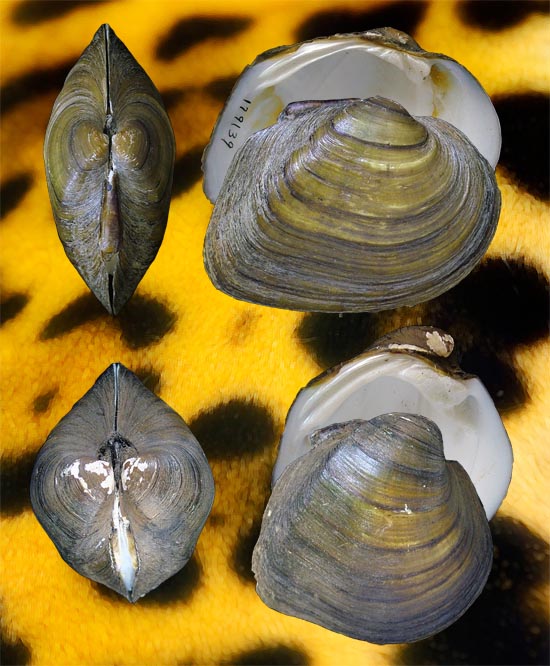| Page last updated
3 November 2009 |
Mussel of the Month
The November 2009 Mussel of the Month is Fusconaia flava. As we currently recognize it, Fusconaia is a North American genus of 15 species. That assessment is likely to change as revisions proceed.

TOP: ANSP 179139. Eel River, N Wabash, Wabash Co., Indiana. C. Goodrich!
Bottom: ANSP 364753. Lake Onalaska, Mississippi River, Lacrosse Co., Wisconsin. S.L.H. Fuller!
|
Early in the 20th century, most of the red-bodied, tetrabranchous species of the Pleurobemini we sequestered into the genus Fusconaia to acknowledge their distinction from Pleurobema, Elliptio, etc. Recent phylogenetic work has brought that arrangement into question (Campbell et al., 2005), but the issue is far from settled. In our checklist (Graf & Cummings, 2007), we kept all the historical species of Fusconaia together for lack of a better solution. But we can sweep all that under the rug for the moment to talk about Fusconaia flava. That species is the type of the genus, and so it will remain a Fusconaia no matter what happens its current congeners (assuming Fusconaia isn't sunk altogether!).
F. flava is a widespread freshwater mussel that is found in a variety of habitats, and its conchological variation typifies a phenomenon known as Ortmann's Law of Stream Position. A.E. Ortmann (1920) was among the earliest to systematically investigate the relationship between infraspecific morphological variation in mussels and stream size. In summary, Ortmann found that, within single widespread species like F. flava, as one samples upstream or downstream, shell morphology changes in a predictable way. Toward the headwaters, shells tend to be more laterally compressed and elongate, with centrally placed centrally. Individuals occupying larger rivers will be more obese and trigonal, with high umbos shifted to the anterior.
Fusconaia flava is not the only species exhibit this common pattern, suggesting a common mechanism. Watters (1994) has shown that the obese big-water shell morphology serves as a better anchor in the lamellar flow of a big river, whereas the upstream form is a better burrower. DLG (Graf, 1997) documented the pattern of gradual change in shell morphology from one extreme environement to the next. |
Classification:
Phylum Mollusca
Class Bivalvia
Subclass Palaeoheterodonta
Order Unionoida
Superfamily UNIONOIDEA Rafinesque, 1820
Family UNIONIDAE s.s.
Subfamily AMBLEMINAE Rafinesque, 1820
Tribe Pleurobemini Hannibal, 1912
Genus Fusconaia Simpson, 1900
Species Fusconaia flava (Rafinesque, 1820) |
For more information about the taxonomy of Fusconaia and Ortmann's Law, check out:
- Campbell, D.C., J.M. Serb, J.E. Buhay, K.J. Roe, R.L. Minton & C. Lydear. 2005. Phylogeny of North American amblemines (Bivalvia, Unionoida): prodigious polyphyly proves pervasive across genera. Invertebrate Biology 124: 131-164.
- Graf, D.L. & K.S. Cummings. 2007. Review of the systematics and global diversity of freshwater mussel species (Bivalvia: Unionoida). Journal of Molluscan Studies 73: 291-314.
- Graf, D.L. 1997. Morphology, Zoogeography, and Taxonomy of Fusconaia flava (Rafinesque) (Mollusca: Bivalvia: Unionidae) in the Upper Mississippi, Great Lakes, and Nelson River Basins. M.Sc. Thesis, Northeastern University, Boston, MA. 105 pp.
- Ortmann, A.E. 1920. Correlation of shape and station in freshwater mussels (Naiades). Proceedings of the American Philosophical Society 19: 269-312.
- Watters, G.T. 1994. Form and function of unionoidean shell sculpture and shape (Bivalvia). American Malacological Bulletin 11: 1-20.
|